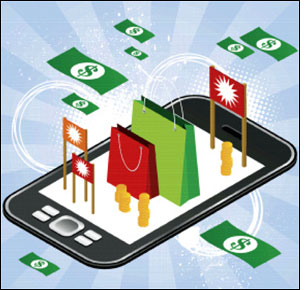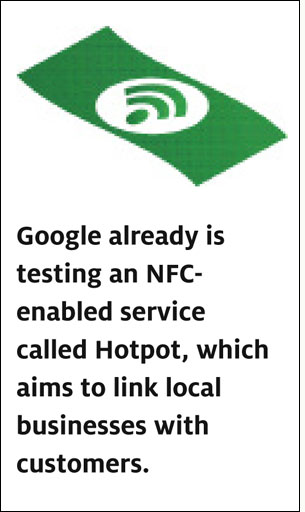Banks, credit card issuers, telecommunications providers and cellular-phone manufacturers all are battling to carve out a role in the nascent mobile-payments market. In May, Google unveiled plans to offer a mobile-payment system in cooperation with Citibank, MasterCard, First Data and Sprint. The Google Wallet will let owners of cell phones running Google’s Android operating system, and equipped with Near-Field Communication (NFC) technology, pay for goods with a tap of their phones at point-of-sale terminals.
NFC is a short-range, high-frequency wireless technology that enables data exchange between two NFC-equipped devices. Other technologies compete in the mobile payment space, including 2-D bar codes and various biometric technologies (fingerprint scanners, for instance). But the fact that a dominant technology company like Google is betting on NFC suggests NFC is the front-runner among mobile-payment technologies.
Many businesses are focused on NFC—a form of RFID—because the technology can do more than just facilitate transactions. An NFC tag can store more data than a 2-D bar code, and an NFC-enabled phone can both read tags and emulate them. So, for example, a consumer could use an NFC phone to download tickets to a baseball game, then swipe the phone by a reader at the turnstile to gain entry to the ballpark.
In fact, it’s NFC’s versatility that gives it an edge over rival technologies and opens the door to a wide variety of uses. Several applications featured in our cover story, “101 Innovative Ways to Use RFID,” employ NFC technology. Monks living in a 13th-century Czech monastery, for example, provide visitors with NFC devices so they can access information in their own languages).
Consumers participating in trials have used their NFC phones to purchase and store monthly transit tickets for trains, buses and other public transportation, as well as buy one-way tickets and change tickets on the fly—all by logging in to the transit provider’s Web site. Others studies have proved that NFC phones can replace paper airline boarding passes, building access-control cards and hotel room keys (a recent test in Sweden was hugely popular with guests).
Museums could place NFC tags near individual works of art, and visitors could use NFC phones or other devices to read the tags and download print or audio descriptions (this would replace cumbersome audio tours that require visitors to view works in a specific order). Retail malls, hospitals, college campuses and other complexes could put NFC tags on signs, so visitors could download maps indicating their current locations.
Google already is testing an NFC-enabled service called Hotpot, which aims to link local businesses with customers. Hotpot is an adjunct to Place Pages, a service Google launched in September 2009 that lets businesses create Web pages where the search engine’s users can find information about the business’ hours of operation, photos, videos and coupons, as well as customer ratings and reviews. The Web link for a company’s Place Page appears whenever the company’s name turns up in a Google search results page.
Hotpot features an NFC tag embedded in a sticker that attaches to the front of a business’ door or window. The tag is encoded with an ID number that instructs NFC phones to display the appropriate Place Page for that business. Consumers tap their NFC phones against the sticker to access information about the establishment before determining whether to enter, or, in the case of a restaurant, make reservations. The service also lets people share their recommendations with friends and family, and add ratings or reviews to the business’ Place Page, prompting the search engine to tailor its future results for that user based on his or her ratings.
Individual businesses also are experimenting with NFC’s capabilities. Britain’s largest mobile-phone service provider, O2, has introduced O2 Homecare in partnership with software company Reslink. The system lets home-care providers access individual patient-care records by using an NFC phone to scan a tag in each patient’s home. The service could be provided to home-care companies or patients, and be billed as an add-on expense for mobile services.
CustomerIn Systems, a software-development company in Vancouver, B.C., provides NFC solutions for restaurants, bars and other entertainment establishments. The Connected Restaurant application, for example, lets diners use their NFC phones to request tables and order appetizers or drinks while they wait. Once seated, they can read the NFC-enabled menu to get information about an entrée’s ingredients, calorie count or sodium content.
This year, at RFID Journal LIVE! 2011, Bethesda, Md.-based ITN International provided exhibitors with NFC-enabled Nexus S mobile phones, and we equipped attendees’ badges with NFC tags. When an attendee visited an exhibitor’s booth, the vendor could capture the person’s contact information. The system also let each vendor create a set of questions to ask attendees to qualify them as sales prospects. The answers were uploaded via either Wi-Fi or a cellular link to ITN’s servers, so vendors could retrieve the information after the event.
Nokia and other mobile-phone manufacturers are adding NFC capabilities to their handsets. It’s not clear how quickly NFC mobile payments will catch on, because retailers need to upgrade their point-of-sale equipment to accept payments from the phones. Meanwhile, innovative companies are already devising new and clever ways to take advantage of this form of RFID.



